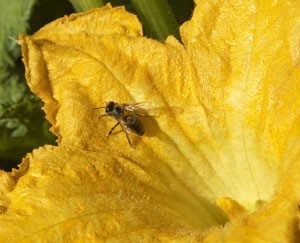
Many of the more mysterious problems that come up during the gardening season can be traced to the pollination process going awry. Crops look healthy but fail to produce fruit, flowers fail to set seed, and yet there are no observable signs of insect damage or disease. Then there's the bizarre-shaped vegetable or odd-colored flower that suddenly springs out of nowhere. If any of these scenarios sound familiar, you may have experienced a pollination problem.
When gardeners think about how plants are pollinated, it's usually bees and other beneficial insects that immediately come to mind. The truth is, plants are pollinated in a number of different ways. Some plants are self-pollinators, some are pollinated by the wind, some are pollinated by other flowers or plants, and others rely on insects. Understanding how the plants in your garden are pollinated is a good first step eliminating a number potentially disappointing problems.
In order to set seed (and fruit), a flower must first be pollinated. During the process, pollen is transferred from the male part of the flower (anther) to the female part of the flower (stigma). The tiny pollen grain then grows down the style to the ovary, where it fertilizes the eggs. The eggs develop into embryos, which will be enclosed in the seed where they remain ready and waiting to grow into new plants. Pollination in plants is of two types: self-pollinators and cross-pollinators.
Self-pollinators are plants that are capable of producing and pollinating their own flowers. These plants face less of a risk of being cross-pollinated by other varieties, because the self-pollinating process often happens before the flowers even open.
Cross-pollinators are plants that rely on pollen from other flowers or plants in order to produce seed. Pollen is transferred by insects, the wind or a combination of the two. The seeds of cross-pollinators are harder to keep pure, because the plants can be pollinated by other varieties of the same plant, other plants belonging to the same family, or by wild relatives.
When different varieties of plants cross, the results can be unpredictable. In some cases the plants may be rendered sterile and they will fail to produce any offspring at all. In other cases, a whole new (and improved) variety emerges. This can be spectacular or horrifying, but it's always interesting.
The term hybrid can be confusing for gardeners. In simplest terms, a hybrid plants refers to a plant that has resulted from the crossing of two pure parent plants. The term F1 hybrid stands for "first filial generation.' This simply means that the plant is the first generation offspring (F1) from the crossing of the two pure parent plants. An F2 hybrid is from the second generation. An F1 hybrid may possess the desired qualities of either or both parents. Saving seeds from these hybrids is not recommended, because the resulting offspring is not likely to be true to the plant that produced the seeds.
Self-Pollinators: lettuce, pansy, peas, tomatoes and zinniaWind-Pollinated: Amaranthus (Love-Lies-Bleeding), spinach and sweet cornInsect-Pollinated: basil, cabbage, columbine, foxglove, French marigold, nasturtium, pepper, primrose, poppy, pumpkin, radish, squash, and sunflower.

About The Author: Ellen Brown is our Green Living and Gardening Expert. Click here to ask Ellen a question! Ellen Brown is an environmental writer and photographer and the owner of Sustainable Media, an environmental media company that specializes in helping businesses and organizations promote eco-friendly products and services. Contact her on the web at http://www.sustainable-media.com
Add your voice! Click below to comment. ThriftyFun is powered by your wisdom!
Do on wind pollination also.
Where can I find a list of self-pollinating flowers?
Add your voice! Click below to comment. ThriftyFun is powered by your wisdom!